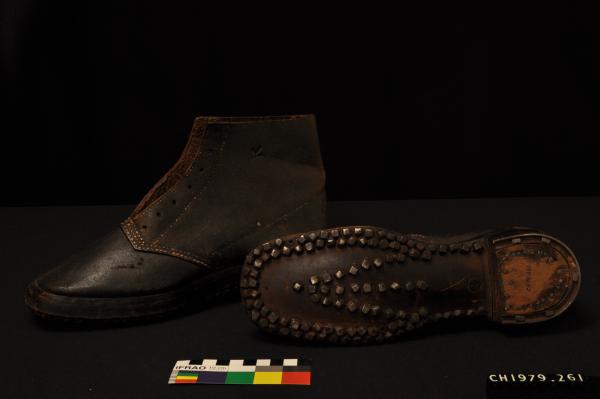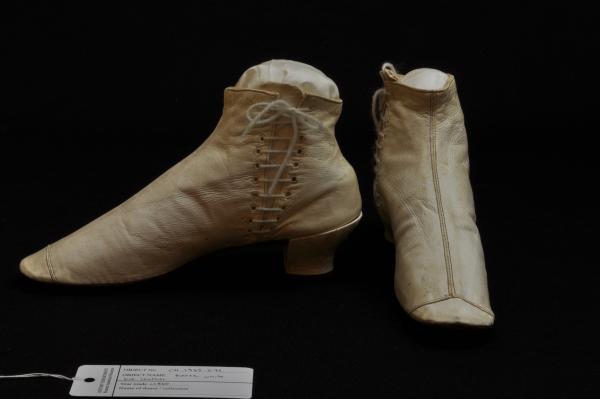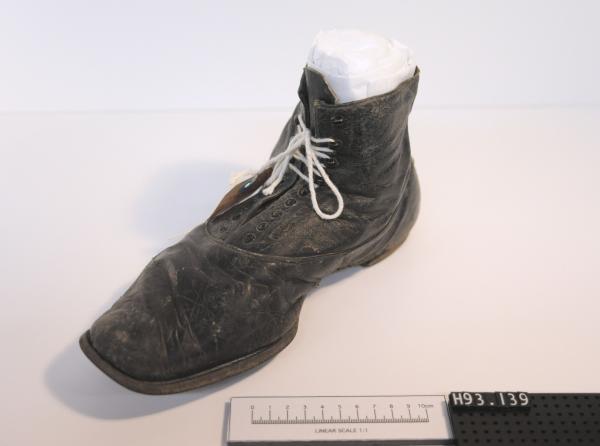4 SHOE FRAGMENTS
CH1977.108.a-d
(a) Sole of a pointed shoe found in Little Britain. 14th Century.
(b) Forepart of shoe. Found in Little Britain. 14th Century.
(c) Child's shoe found in Moorfields. 15th Century.
(d) Portion of a broad-toe shoe. 16th Century.
Addition: Information supplied by June Swann, world authority on historic shoes visiting from UK, during her inspection of shoe collection 18th October 1993.
a) Sole man's shoe. A good size. Has been repaired with stitches at waist - 5 to the inch. Edge flush 4 1/2 to 1". Looks as if its been used as a base for stamping things out on - much later pinking marks - may - imprinted into leather.
Probably 1450-65 (Wars of Roses period). ie. 15th century not 14th century. Pointed.
b) side laced. 4 pairs of holes surviving. Cut upper. Probably was from a leg boot. V-shaped seam does not make sense if it was a side laced boot - thus probably from boot. More likely 15th century. Has had facing under stitch holes. Has had binding around edge at top of foot. Buffed seam here. 5 stitches to 1 inch. No side lining. Lines inside suggest that is may have been lined. Modest toe - modest for 15th century. Probably prominant little toe. Probably right foot, lacing on inside. Probably no bunion on wearer.
c) Child's leather ankle-boot. Pointed toe; no heel. AB66 - Museum of London number. Nice little sole . Street dirt. Has been in contact with cloth - fragment remaining on. Joined at outside waist (so join visible). No back seam. A one-piece wrap-around upper. Front is cut, and has one strap and circular buckle remaining - rusty iron, probably held on with thin strap. May have had bellows tongue. Comform to standard pattern but a very nice child's boot. Toe worn out - child has grown out of it.
d) Not a very broad shoe - was up to 8". AB.67 - Museum of London number?
May be man's , but slightly possible may be woman's or youth. has been too narrow for wearer - the earlier shoes were even broader, so feet could grow very ?
Typical early 20th century museum cobbling - large, crude stitches. Toe lined originally. Repaired - cut with stitch holes at waist for repair - probably heel was repaired. 4 stitches to the inch.
Quare throat cut - almost certainly not what the shoemaker did. Pair of side seams. 1 1/2" high only at side seams - not very practical for muddy streets.
Back end missing - bacause uppers joined and sole repaired.
Hole at side may be from tying pairs together, or to attach buckle. Was buckle-bar shoe 1530s.
Department:
History DepartmentCollection
| Accession Number: | CH1977.108.a-d |
|---|---|
| Accession Date: | 3 Mar 1977 |
| Acquisition Year: | 1938 |
| Credit: | Guildhall Museum |
Material
| Leather | 0 - Whole |
|---|
Measurement
| length | 260mm |
|---|
| length | 240mm |
|---|
| length | 155mm |
|---|
| length | 160mm |
|---|
The WA Museum is in the process of digitising its collections. This record may not have been reviewed by curatorial staff and may be inaccurate or incomplete. Research departments are continually working on these collections by adding new objects and reviewing existing content when new information is made available.
Enquiries can be emailed to reception@museum.wa.gov.au
Cite this page
Western Australian Museum Collections https://museum.wa.gov.au/online-collections/content/CH1977.108.-d
Accessed 16 Aug 2024
Rights
We support the open release of data and information about our collections.
Text content on this page is licensed under a Creative Commons Attribution 4.0 International License.
Image content on this page is copyright WA Museum.







